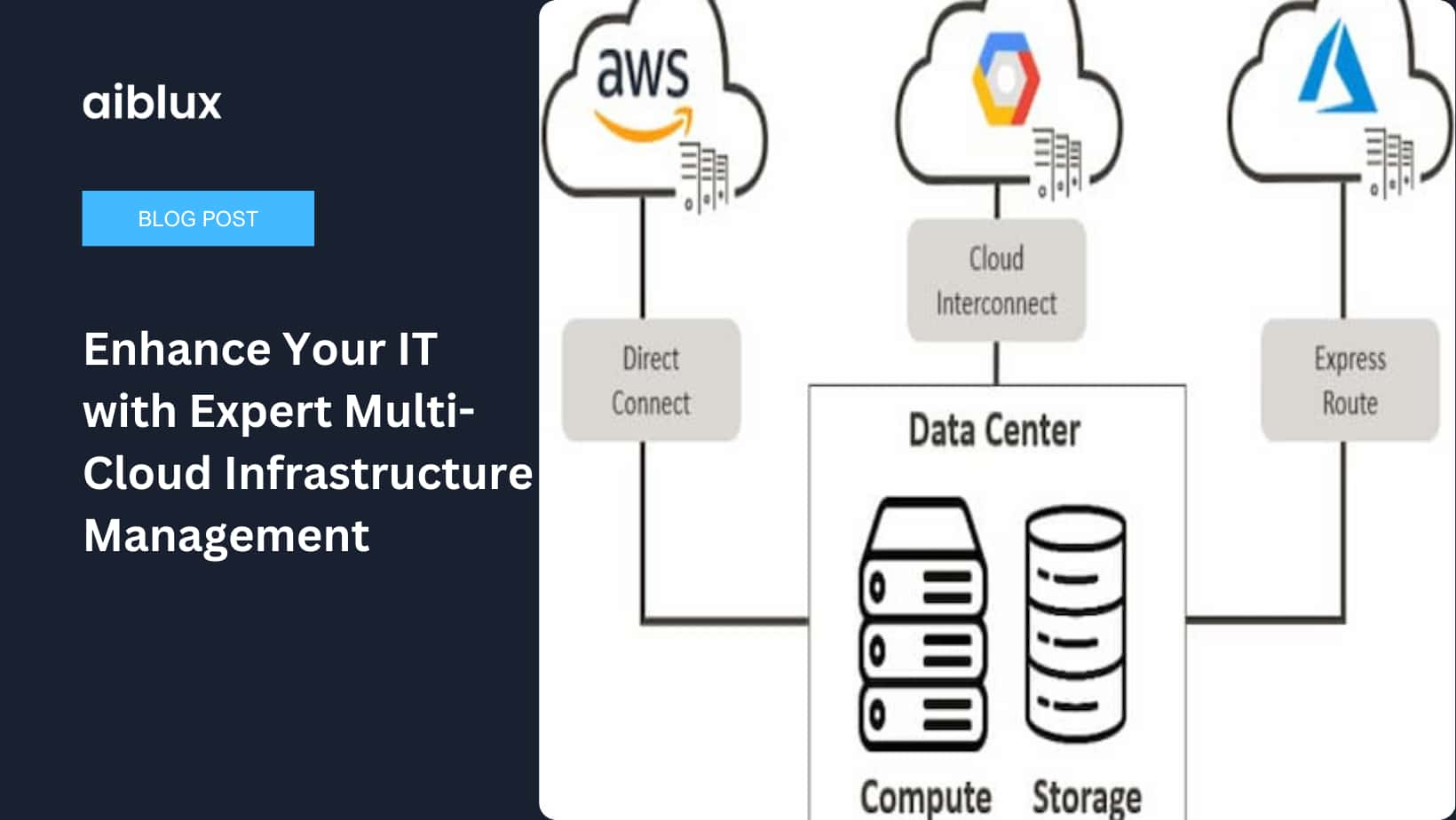Introduction
In today’s fast-paced digital landscape, efficient multi-cloud infrastructure management is paramount for businesses striving to maintain competitive advantages. At aiblux, we specialize in delivering client-centric software solutions, ensuring that your IT infrastructure is agile, secure, and scalable. This blog post explores how our expert multi-cloud management services can enhance your IT operations, offering practical insights and actionable steps tailored to your unique business needs.
Understanding Multi-Cloud Infrastructure

Multi-cloud infrastructure involves utilizing multiple cloud services from different providers, such as AWS, Azure, and Google Cloud, to optimize performance, cost, and reliability. By leveraging the strengths of each platform, businesses can avoid vendor lock-in, enhance data redundancy, and improve disaster recovery capabilities. However, managing such a diverse environment requires expertise, strategic planning, and robust tools.
Benefits of Multi-Cloud Management
1. Increased Flexibility and Scalability
Multi-cloud environments allow businesses to scale their operations seamlessly by distributing workloads across various platforms. This flexibility ensures that resources can be allocated based on current demands, enhancing efficiency and reducing costs.
2. Enhanced Security and Compliance
Utilizing multiple cloud providers can bolster security by implementing diverse security protocols and compliance standards. This approach minimizes vulnerabilities and ensures adherence to industry regulations, safeguarding sensitive data.
3. Cost Optimization
By strategically distributing workloads, businesses can leverage the most cost-effective services from each provider. This optimization reduces overall expenses while maintaining high performance and reliability.
4. Disaster Recovery and Business Continuity
Multi-cloud setups provide robust disaster recovery solutions by replicating data across different platforms. This redundancy ensures that operations can continue smoothly even in the event of a failure, minimizing downtime and potential losses.
Key Strategies for Effective Multi-Cloud Management
1. Comprehensive Assessment and Planning
Before adopting a multi-cloud strategy, conduct a thorough assessment of your current IT infrastructure, business goals, and specific requirements. This analysis helps in identifying the optimal mix of cloud services and formulating a strategic plan that aligns with your objectives.
2. Centralized Management Tools
Implement centralized management tools that provide a unified view of your multi-cloud environment. These tools streamline monitoring, automation, and orchestration processes, ensuring efficient management and quick resolution of issues.
3. Automation and Orchestration
Leverage automation to handle routine tasks, such as scaling, load balancing, and security updates. Orchestration tools can manage complex workflows across multiple clouds, enhancing operational efficiency and reducing manual intervention.
4. Security Best Practices
Adopt stringent security measures, including encryption, access controls, and continuous monitoring. Regularly update security protocols to address emerging threats and ensure compliance with industry standards.
5. Performance Monitoring and Optimization
Continuously monitor the performance of your multi-cloud environment using advanced analytics and performance metrics. Identify bottlenecks and optimize resources to maintain high performance and availability.
Case Study: Successful Multi-Cloud Management Implementation
At aiblux, we recently assisted a leading logistics company in implementing a robust multi-cloud infrastructure. The client faced challenges in scalability, data security, and cost management. Our team conducted a comprehensive assessment, developed a tailored strategy, and implemented centralized management tools. As a result, the client achieved a 30% reduction in operational costs, enhanced security compliance, and seamless scalability to meet growing demands.
Best Practices for Multi-Cloud Governance
1. Establish Clear Policies and Procedures
Define governance policies that outline roles, responsibilities, and processes for managing the multi-cloud environment. Ensure that these policies are communicated effectively across the organization.
2. Regular Audits and Compliance Checks
Conduct regular audits to ensure compliance with industry standards and internal policies. Identify and address any gaps or vulnerabilities promptly to maintain a secure and compliant environment.
3. Continuous Training and Education
Invest in continuous training programs for your IT staff to keep them updated on the latest multi-cloud technologies, tools, and best practices. This knowledge empowers your team to manage the environment efficiently and effectively.
4. Vendor Management and Collaboration
Foster strong relationships with cloud service providers to ensure seamless collaboration and support. Regularly review and negotiate service level agreements (SLAs) to align with your business needs and expectations.
Future Trends in Multi-Cloud Management

1. AI-Driven Cloud Management
Artificial Intelligence (AI) is revolutionizing multi-cloud management by providing predictive analytics, automated decision-making, and intelligent resource allocation. AI-driven tools enhance efficiency and reduce the complexity of managing diverse cloud environments.
2. Edge Computing Integration
The integration of edge computing with multi-cloud infrastructure is gaining traction, enabling real-time data processing closer to the source. This approach reduces latency, enhances performance, and supports the growing demand for IoT applications.
3. Quantum Computing
Quantum computing holds the potential to transform multi-cloud management by solving complex problems at unprecedented speeds. Although still in its early stages, this technology promises significant advancements in data processing and security.
Conclusion
Multi-cloud infrastructure management is a strategic approach that offers unparalleled flexibility, security, and cost optimization. By adopting best practices and leveraging the expertise of aiblux, businesses can navigate the complexities of multi-cloud environments and achieve their IT goals effectively.
Ready to transform your IT with expert multi-cloud management? Contact us or explore our services to learn how we can help you achieve your business goals.
